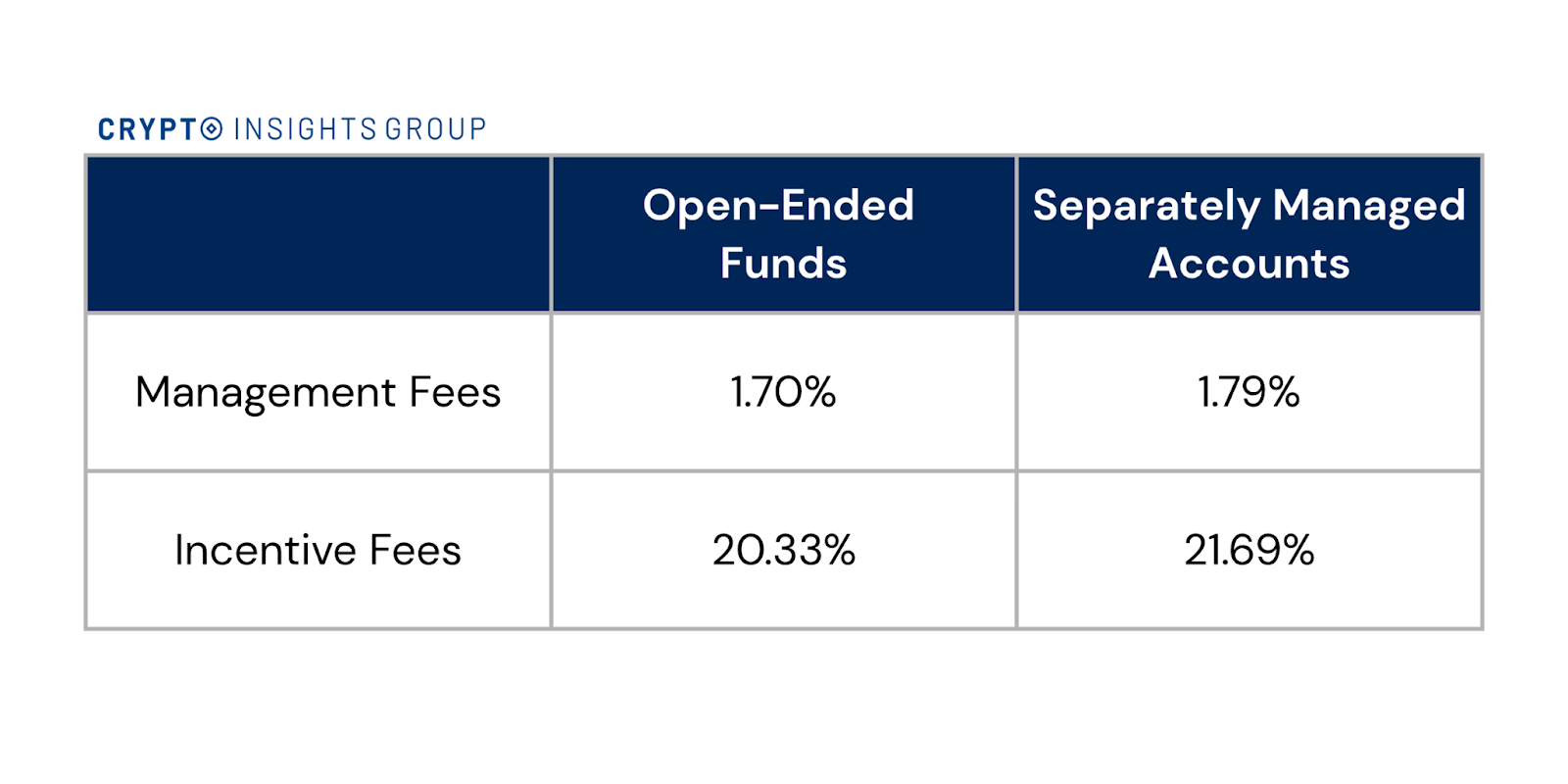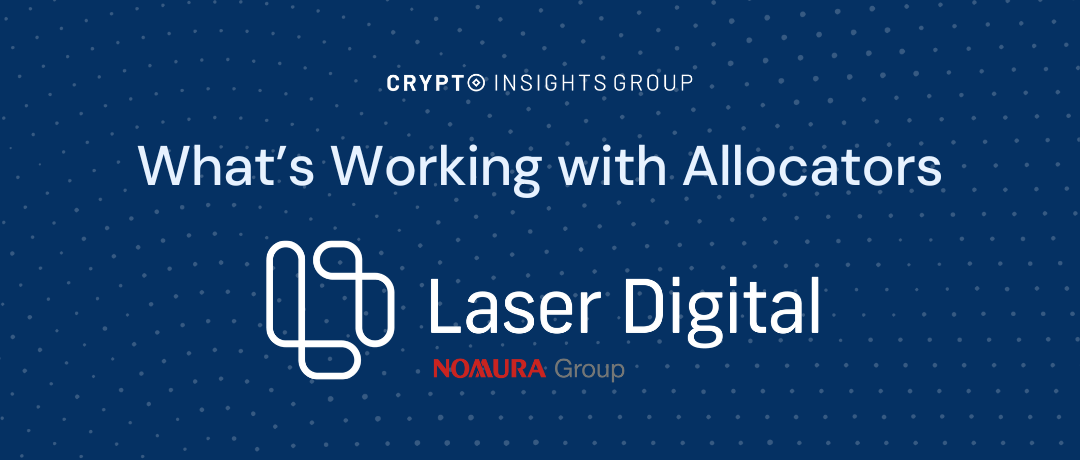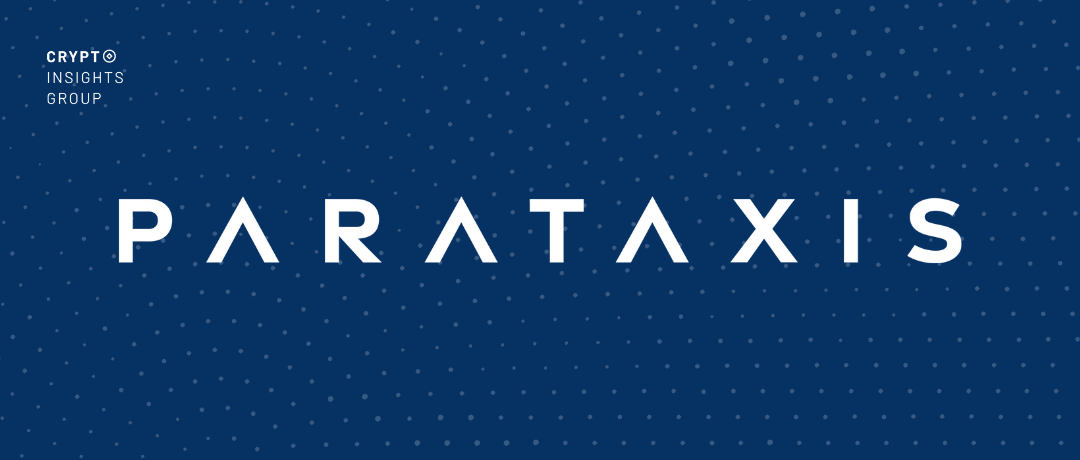In This Article
- Strategy Matters
- Now For The Numbers
- What About Expenses?
- Preparing for Negotiations
- FAQ: Crypto Fund Fees & Expenses
- Book a Crypto Insights Group Demo
A good indicator for a pick up of interest in, and eventual allocation to, a fund investment is when people begin to ask questions about fees and expenses; And for crypto allocations, this leading indicator has been showing itself frequently in recent months. In fact, I’ve had a number of reach outs from both investment managers and institutional investors asking what the “average” management and incentive fees (also structured as performance fees) look like for crypto hedge funds, which is typically coupled with the follow-up inquiry of, “What are generally accepted fund expenses?"
I’ll provide the latest data from Crypto Insights Group’s Platform a little further in this blog, as I’m sure many would like to know what the numbers show. However, before I report on the data, let’s first set some perspective and context.
Strategy Matters
To cast all crypto hedge funds into one lot, or specifically as a sole strategy, would be inaccurate, as most investors certainly don’t lump all traditional hedge fund strategies into one grouping. Just as there are long/short, macro, event driven, etc. strategies for non-crypto hedge funds, there are also strategies for liquid crypto funds (not all are “hedged,” to be sure and therefore includes long-only private placement offerings). In the broadest of descriptions, most crypto funds fall under either market neutral or directional, with various sub-categories, such as quant-market neutral, delta-market neutral, directional-long, directional-fundamental, and for which some are natively crypto-only, i.e., DeFi/Yield. Yes, even the tried and true strategies of macro, event driven and arbitrage (of various types) apply here too.
All of the above is to state, in general, most of the industry guidance for investment managers to set their account fees (either for comingled funds or separately managed accounts - SMAs) are largely based on: 1) What strategy they are running?, 2) The time period for which investor capital is held in an account (i.e., lock-ups), 3)The period for which fee crystallization occurs, and 4) What fees are being charged by other managers running the same or similar strategies. There is also a potential fifth factor that may play into fee determination, which is how commercially appealing an account’s fees are, or simply put, investors' fee tolerance, that could cause a manager to adjust their fees.
Now For The Numbers…
As Crypto Insights Group’s Platform includes a database of hundreds of liquid crypto funds and SMAs, we’ve compiled the following data to provide high quality and factual research on what the average fees are across each vehicle type.

From our analysis, most investment managers of all strategy types are charging a range of 1.5% - 2.0% in management fees across accounts, which are typically assessed monthly, with some outliers assessing their management fees quarterly or annually. In scrutinizing the data further, we see the average open-ended fund has a 1.70% management fee, while the average SMA management fee is 1.79%. In comparison to traditional hedge fund strategies, this management fee range is in-line with what is often charged across the industry.
With respect to incentive fees, most of the sample averages to approximately a 20% fee, with a few outliers charging a 15% fee (often fund of funds), wherein open-ended structures average to approximately a 20% incentive fee and SMAs average to a nearly 22% incentive fee. However, as a stand out statistic we note a divergence with crystallization periods… Here ~21% of open-ended funds calculate their incentive fee quarterly, and ~77% calculate annually. For SMAs, nearly 40% calculate quarterly, and 56% annually.
What About Expenses?
Not to assume all professional investors look into the following, account fees only paint part of the picture when considering the factors which go into net performance returns. Expenses are also an important part of the due diligence process, as such scrutiny may serve an investor well.
Most operational expenses for both comingled funds and SMAs include trading (i.e. broker and/or exchange) costs, and if required, custodial fees (remember, self-custody is a common practice for certain crypto assets). Where the divergence of increased expense occurs most often for commingled funds is with the engagement of additional third parties, such as independent fund administrators, auditors and legal counsel.
Where the lines get blurry, or to be more direct, where the scrutiny and tough questions come into play, is when there are those expenses that can be a push and pull between a cost an investment manager should cover, and those which may be borne by a fund or SMA.
A list of grey-area expenses include:
- Insurance Costs - Many managers buy policies for errors & omissions (E & O) and directors and officers (D & O). Depending on which errors have occurred (i.e., trading or accounting), and which directors should be protected (i.e., management company or fund board), it may not be appropriate to have a fund bear the total costs of certain insurance policies.
- Marketing Costs - Examples here include the costs of developing and distributing marketing materials, event participation and related travel. For a discerning investor, a manager should demonstrate if such expenses can be directly attributed to the growth (or stability) of a fund, as compared to a manager promoting other investment products for the benefit of their respective firm.
- Research and Development Costs - A less opaque due diligence test here. If a manager can justify the costs of research, or as common for crypto managers - technology development, went into a potential or eventual investment for a fund or SMA, such expenses can be fairly allocated to a client account.
- Travel Costs - This may include some of the above costs relating to marketing or research, but investors have to determine if it is fair to pay for the travel of investment manager employees related to personal travel or non-business purposes.
From our experience, what is most often “fair” with respect to the above costs may be some split or allocation between the manager and its client accounts, but there is no clear standard on whether a split means 50/50, 60/40, etc.
Preparing for Negotiations
Whether you are an investor starting their crypto strategy due diligence process, or an investment manager looking to launch a new comingled fund or work with an investor to open a separate account, being prepared with updated data and industry best practices can prove useful for whichever side of the table one is negotiating from.
For comingled fund managers and investors, the terms and fees presented in offering documents may appear to be set firm, but depending on the potential capital commitment being presented to a manager, fees may be adjusted through agreeing to a side letter. Whereas costs, over time, should decrease as a percentage of net returns if a fund’s assets under management are growing through both return of investment and diversifying a fund’s client base, both manager and investor should benefit in the long run.
If a manager or investor is in the position to build an SMA structure together, fee and expense negotiations should be addressed at the outset of such arrangements.
At Crypto Insights Group, we collect and maintain the highest quality crypto fund data to benefit both our fund manager and institutional allocator clients, providing analysis through our Platform tools and due diligence services, and are happy to support your operational needs.
FAQ: Crypto Fund Fees & Expenses
How do crypto hedge fund fees compare to traditional hedge funds?
Crypto hedge funds generally align with the classic “2 and 20” structure, but allocator pressure has driven averages lower. Benchmarking data shows management fees closer to 1.5% and performance fees trending toward 15 to 17.5 percent depending on strategy and liquidity profile.
What are the most common fund expenses investors should expect?
Core expenses include administration, custody, audit, and legal. Technology, research, and data subscriptions are increasingly common. Our benchmarking highlights that grey area expenses are where negotiation and transparency matter most.
Why is benchmarking fees and expenses important for allocators?
Without benchmarking, allocators risk overpaying relative to peers. Our allocator-grade dataset allows LPs to compare fees across more than 300 managers and strategies, ensuring terms are in line with market standards.
Can investors negotiate fee breaks or expense caps?
Yes. Large allocators frequently secure reduced management fees, incentive hurdles, or caps on pass-through expenses. Negotiating from a data-driven benchmark position strengthens the allocator’s hand.
How does Crypto Insights Group collect and verify fee and expense data?
Crypto Insights Group sources directly from managers and fund administrators, then normalizes across strategy categories. The FirmIQ™ framework layers operational due diligence on top of raw benchmarking, helping allocators assess not just costs but operational robustness.
Why is it important to be more than just a database provider?
A database can surface raw numbers, but allocators need allocator-grade insights. Crypto Insights Group goes beyond data collection by embedding operational due diligence, FirmIQ™ scoring, and peer benchmarking into one platform. This allows institutions to evaluate not only fees and expenses, but also the operational readiness and robustness of each manager, giving allocators confidence to move from analysis to allocation.
Book a Crypto Insights Group Demo
Ready to see how fees and expenses compare to peers?


.png)


